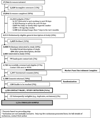Snus undermines quit attempts but not abstinence: a randomised clinical trial among US smokers
- PMID: 27071730
- PMCID: PMC5061602
- DOI: 10.1136/tobaccocontrol-2015-052783
Snus undermines quit attempts but not abstinence: a randomised clinical trial among US smokers
Abstract
Background: Observational studies and a few clinical trials suggest that use of low nitrosamine smokeless tobacco (snus) can facilitate smoking cessation. To better understand the real-world impact of snus on smoking behaviour, a large-scale, long-term clinical trial of naturalistic snus use among smokers is needed.
Study design: A nationwide clinical trial compared abstinence outcomes among smokers who were randomised to receive free samples of snus versus not. Participants (N=1236) were recruited throughout the US and assessed for 1 year following a 6-week naturalistic sampling period, with high retention throughout. Primary outcomes included self-reported quit attempts, floating abstinence (any 7-day period of non-smoking) and 7-day point-prevalence abstinence at 6 months and 12 months. Secondary outcomes were changes in smoking, motivation and confidence to quit and adverse events. No tobacco industry support was provided.
Results: Within snus group, 82% used at least once, and 16% were using regularly at end of sampling period. Compared to control participants, smokers in the snus group were less likely to make any quit attempt (RR=0.83; 95% CI 0.70 to 1.00), and any 24 h quit attempt (RR=0.77; 95% CI 0.63 to 0.95). There were no group differences on any measure of abstinence.
Conclusions: Provision of snus in a naturalistic context resulted in minimal uptake, and as a whole, undermined quit attempts and did not increase smoking abstinence. Results do not support the unguided, free provision of snus among smokers not motivated to quit as a means to facilitate quit attempts.
Trial registration number: NCT01509586, Results.
Keywords: Cessation; Harm Reduction; Non-cigarette tobacco products.
Published by the BMJ Publishing Group Limited. For permission to use (where not already granted under a licence) please go to http://www.bmj.com/company/products-services/rights-and-licensing/.
Conflict of interest statement
Drs. Alberg, Burris, Carpenter, Garrett-Mayer, Wahlquist report no conflicts of interests. Dr. Gray has received support from Merck Inc. and Supernus Pharmaceuticals for unrelated research. Dr. Cummings has received support from Pfizer for the evaluation of a hospital based cessation program, and has received payment as an expert witness in litigation against cigarette companies.
Figures



Similar articles
-
Randomized Trial to Compare Smoking Cessation Rates of Snus, With and Without Smokeless Tobacco Health-Related Information, and a Nicotine Lozenge.Nicotine Tob Res. 2019 Jan 1;21(1):88-94. doi: 10.1093/ntr/nty011. Nicotine Tob Res. 2019. PMID: 29373698 Free PMC article. Clinical Trial.
-
Motivational support intervention to reduce smoking and increase physical activity in smokers not ready to quit: the TARS RCT.Health Technol Assess. 2023 Mar;27(4):1-277. doi: 10.3310/KLTG1447. Health Technol Assess. 2023. PMID: 37022933 Free PMC article.
-
Cigarette smoking cessation attempts among current US smokers who also use smokeless tobacco.Addict Behav. 2015 Dec;51:113-9. doi: 10.1016/j.addbeh.2015.06.045. Epub 2015 Jul 4. Addict Behav. 2015. PMID: 26253939 Free PMC article.
-
Brief, instructional smokeless tobacco use among cigarette smokers who do not intend to quit: a pilot randomized clinical trial.Nicotine Tob Res. 2014 Apr;16(4):397-405. doi: 10.1093/ntr/ntt161. Epub 2013 Oct 15. Nicotine Tob Res. 2014. PMID: 24130144 Free PMC article. Clinical Trial.
-
[Smoking reduction and temporary abstinence: new approaches for smoking cessation].J Mal Vasc. 2003 Dec;28(5):293-300. J Mal Vasc. 2003. PMID: 14978435 Review. French.
Cited by
-
Oral Nicotine Product Awareness and Use Among People Who Smoke and Vape in the U.S.Am J Prev Med. 2022 Oct;63(4):611-618. doi: 10.1016/j.amepre.2022.04.019. Epub 2022 Jun 4. Am J Prev Med. 2022. PMID: 35667923 Free PMC article.
-
One-Year Smoking Trajectories Among Established Adult Smokers With Low Baseline Motivation to Quit.Nicotine Tob Res. 2017 Dec 13;20(1):50-57. doi: 10.1093/ntr/ntw264. Nicotine Tob Res. 2017. PMID: 27694437 Free PMC article.
-
Application of the Smokeless Tobacco Expectancies Questionnaire to Snus.Am J Health Behav. 2016 Sep;40(5):652-8. doi: 10.5993/AJHB.40.5.12. Am J Health Behav. 2016. PMID: 27561868 Free PMC article.
-
Effectiveness and Safety Profile of Alternative Tobacco and Nicotine Products for Smoking Reduction and Cessation: A Systematic Review.J Multidiscip Healthc. 2021 Jul 23;14:1955-1975. doi: 10.2147/JMDH.S319727. eCollection 2021. J Multidiscip Healthc. 2021. PMID: 34326646 Free PMC article. Review.
-
Assessing likelihood of product use for snus with modified-risk information among adult current cigarette smokers, former tobacco users, and never tobacco users.Addict Behav Rep. 2019 Jul 26;10:100208. doi: 10.1016/j.abrep.2019.100208. eCollection 2019 Dec. Addict Behav Rep. 2019. PMID: 31467967 Free PMC article.
References
-
- Krautter GR, Chen PX, Borgerding MF. Consumption patterns and biomarkers of exposure in cigarette smokers switched to Snus, various dissovable tobacco products, Dual use, or tobacco abstinence. Regulatory Toxicology and Pharmacology. 2015;71:186–197. - PubMed
-
- Levy DT, Mumford EA, Cummings KM, et al. The relative risks of a low-nitrosamine smokeless tobacco product compared with smoking cigarettes: Estimates of a panel of experts. Cancer Epidemiology, Biomarkers & Prevention. 2004;13:2035–2042. - PubMed
-
- Levy DT, Mumford EA, Cummings KM, et al. The potential impact of a low-nitrosamine smokeless tobacco product on cigarette smoking in the United States: Estimates of a panel of experts. Addictive Behaviors. 2006;31:1190–1200. - PubMed
Publication types
MeSH terms
Associated data
Grants and funding
LinkOut - more resources
Full Text Sources
Other Literature Sources
Medical
